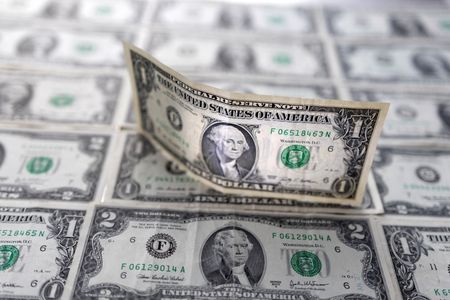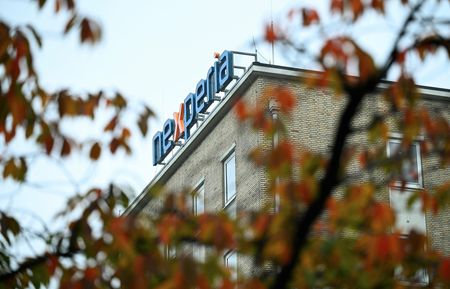By Saqib Iqbal Ahmed
NEW YORK (Reuters) -The dollar rose to a three-month high against the euro on Monday, extending its gains from last week on doubts about the outlook for another Fed rate cut this year.
The Federal Reserve lowered interest rates by 25 basis points last week, as expected, but Chair Jerome Powell signalled that may be the last cut this year, citing the risk of making additional moves without a more robust picture of the economy.
Were it not for the ongoing U.S. government shutdown, data releases scheduled for this week, including U.S. nonfarm payrolls, would have helped with that picture.
With government releases missing, investors will be left with limited non-government sources of economic data, including ADP employment data, to gauge the health of the U.S. economy.
‘QUITE A BIT OF DOUBT’ ABOUT DECEMBER RATE CUT
“There was quite a bit of doubt cast on the likelihood of a follow-up December rate cut,” said Shaun Osborne, chief currency strategist at Scotiabank.
Federal Reserve officials on Monday continued pressing competing views of where the economy stands and the risks facing it, a debate set to intensify ahead of the U.S. central bank’s next policy meeting.
In an appearance on the Bloomberg Surveillance television program, Fed Governor Stephen Miran restated the case for deep interest rate cuts that he has laid out since joining the central bank’s Board of Governors in September.
Chicago Fed President Austan Goolsbee, in contrast, told Yahoo Finance that he was leery of further rate cuts while inflation remains significantly above the central bank’s 2% target and is expected to accelerate through the rest of 2025.
“I don’t recall, in all the years of watching these markets, public division among Fed policymakers as significant as this on the policy outlook,” Osborne said.
Traders are now pricing in a roughly 70% chance of a 25 bp cut in December, down from about 94%, a week ago.
EURO HITS WEAKEST VS DOLLAR SINCE AUGUST
The euro, which slipped as low as $1.1505 against the dollar, its weakest since August 1, pared losses to trade down 0.1% at $1.152225, after data showed U.S. manufacturing contracted for an eighth straight month in October as new orders remained subdued, and suppliers were taking longer to deliver materials to factories against the backdrop of tariffs on imported goods.
“The small decline in the ISM Manufacturing Index in October is not a huge concern, as it was entirely driven by the volatile production component, while new orders and employment both inched higher,” Thomas Ryan, North America economist at Capital Economics, said in a note.
The dollar was up 0.4% to 0.80755 Swiss francs, its highest since mid-August.
Against the yen the dollar was 0.1% higher at 154.19 yen, languishing near an 8-1/2-month low, pressured by wide interest rate differentials.
Still, there remained risks to the dollar, including the U.S. government shutdown that has disrupted the supply of official data crucial to gauging the strength of the economy.
“I don’t think it is guaranteed that the dollar continues to strengthen,” Osborne said.
POUND, YEN FACE THEIR OWN PRESSURES
For now, the pound and the yen face their own pressures.
Even though Bank of Japan Governor Kazuo Ueda last week sent the strongest signal yet that a rate hike was possible as soon as December, markets remained underwhelmed by the central bank’s gradual approach, particularly given that the Fed has turned more hawkish.
That has piled pressure on the yen, prompting jawboning from Japanese authorities to stem the currency’s slide.
The yen is approaching levels at which Japanese authorities intervened in markets in 2022 and 2024 to support the currency.
Sterling has softened as market expectations of another Bank of England rate cut this year increased after softer-than-expected inflation data released last month. On Monday, the pound was 0.1% lower at $1.3133.
The BoE meets this week, with some analysts predicting a 25 basis point cut, though market pricing only reflects a one-in-three chance of this occurring.
The Aussie slipped 0.1% to $0.6538. The currency has found some support from expectations that the Reserve Bank of Australia will hold rates on Tuesday, following an uncomfortably high reading of core inflation.
Cryptocurrency bitcoin <BTC=> was down 2.6% at $107,152.
(Reporting by Saqib Iqbal Ahmed; Additional reporting by Alun John and Rae Wee; Editing by Conor Humphries and Andrea Ricci )











